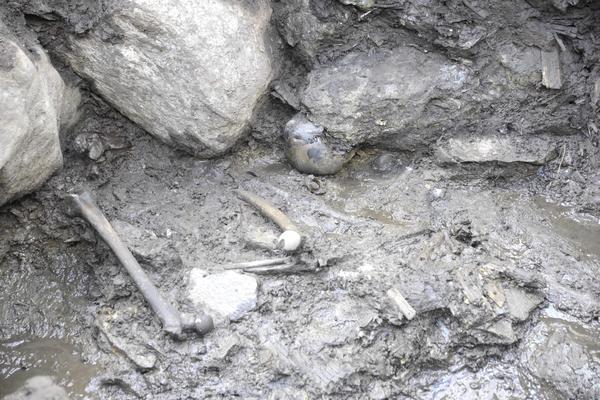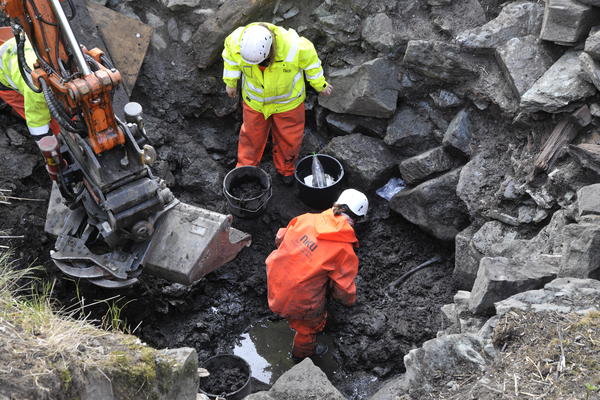
Sverre Sigurdsson (1151-1202) was a Norwegian king between 1177 - 1202. He was raised in the Faroe Islands. Kong Sverre ruled the country in a hectic phase of civil war. He was the founder of a new dynasty, called the Sverreætta, which ruled the country until the union with Sweden in 1319. The present king is a decedent of king Sverre. Sverresborg Trøndelag Folk Museum is built around the ruins of King Sverre's Castle, Norway's first medieval castle.
It all started in 1176. The young Sverre, trained as a priest, travelled from his home in the Faroe Islands to the city of Bergen with the goal to become the king of Norway. He claimed to be a son of king Sigurd Munn and thus entitled to succeed to the throne. Sverre gathered an army of the poor an dispossed, who was called the Birkebeiners. He developed them into an elite unit. His army was called Birkebeiner. The name of the army was because they were so poor that they had to tie birch bark around the legs instead of stockings. The Birkebeiners continued to fight for Sverre’s successor after King Sverre's death in 1202.
- 1/2
- 2/2
Sverre is one of the most controversial and enigmatic person in Norwegian history. He is often described as the most powerful and most important king of Norwegian medieval age. At the cliff above the museum he built Norways first medieval castle. The ruins of the castle are preserved in the museum area as a memory of a very exciting chapter in the country's history.
The civil war period in Norway between 1130 and 1240 was dominated by the struggle between many pretenders to the throne. At the end of the 12th century was the warring factions reduced to two parties, known as the Birkebeiners and the Baglers. The church supported the Baglers because King Sverre and his men wanted to reduce the privileges of the bishops. Sverre wanted a church where the king was the head, while the bishops wanted an independent church where they only was subjects to the pope. The war between the Birkebeiner and the Bagler was especially rough in Trøndelag, the center of the Birkebeiners power.
On the steep cliff in the middle of the open air museum king Sverre built the country's first medieval castle during the winter of 1182-1183. The castle was named Zion after King David's Citadel in Jerusalem. It must have been an impressive sight, with its gate tower, main tower, curtain wall and various buildings. The castle was destroyed twice by Sverre’s enemies. Both times, the castle was rebuilt. Today only the ruins remain of this impressive fortress.
- 1/2
- 2/2
Archeological surveys
Archaeological surveys on the plateau where the castle stood has disclosed a number of discoveries of artifacts. It was found remains of buildings in the form of both coarse processed stone and more elaborately processed stone, iron objects like nails scissors, keys and knives, and soapstone objects like weights for looms. A special discovery was a silver coin bearing the king's portrait and name. Kong Sverre was the king who minted most coins and is the only one who has placed his name on the coin in this period; REX SVERVS MAGNVS, meaning King Sverre the Great.
It was made new archaeological excavations in 2014 and 2016, this time in the well of the castle. Spectacular discoveries were made. These have attracted both national and international attention! The investigations continue.
So is written in the saga of King Sverre:
"The Baglers took all the goods that were in the castle (Sverresborg) and after that they burned every house that was there. They took a dead man and threw him into the well. Then they threw the stones down until it was full. They called the townspeople out to break down all the stone walls completely to the ground before they left. They burnt all of the king's long ships before they went away. After this they took the road to the Uplands in Sweden. They found that they had acquired many good items on this journey "From King Sverre's saga.
Excavations in the well has revealed a dramatic moment in history. The Baglers had managed to take hold of the castle. They must have been ecstatic. The city's male population was ordered to demolish all stone buildings to the ground level, the other houses were burned. They killed a man and threw his body into the well, where they also emptied all buckets of latrine waste
they found. Then they filled the well up with stone from the demolished buildings.
The detected stones is very interesting. They represents a major source of potential for new knowledge of medieval handcrafts, like the castle’s originally architecture and status, and the connection with the stone masons workshop at the Nidaros Cathedral (the Church of Christ). The findings show that the castle has been a honorable facility with great use of decorative shaped stones.



